Tiki Kings Ukulele Lesson, Strumming.
Soooo. After a while, you may find yourself thinking, "My rhythm lacks a certain Je ne sais quois! Each strum produces only a cacophony of ennui" Or, perhaps, "My strumming kinda sucks" The difficulty arises because we are trying to train both the right and left hemispheres of the brain at the same time. Not only that but we are dealing with rhythm, which is a mechanical function, and melody, which is an artistic function. so what to do? Well, the short answere is, practice, practice, practice. This is where a lot of people have trouble, and where it gets a little more complicated. As I said before, strumming is one of those things that could fill an entire book! Musicians work hard to develop unique strums, and some are even famous for the way they strummed, like George Formby, or Roy Smeck. Look these guys up on youtube. You will be amazed. So, good strumming takes practice and there are a couple of ways to go about this. One good way is while you are practicing your strums, don't bother with chords at first, either mute the strings by lightly covering all the strings with your left hand, or just make the easiest chord you can, like a C. Once you get them down, add in the chords. Now, we already know the 4/4 down stroke, and it's not too exciting. So how can we spice it up? Well, first lets add an upstroke. An upstroke is basically just the reverse of the down stroke, where you strum up instead of down. But usually you do the up stroke with your index finger instead of your thumb. So, Down with your thumb, up with your finger. The Upstroke happens between the down strokes. If you are counting 1, 2, 3, 4, the upstroke would be "1 and 2 and 3 and 4 and"... with the upstroke happening on the word "and"
Play it a few times until it feels comfortable
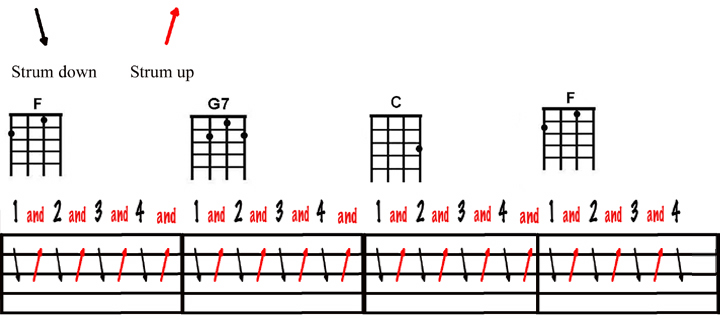
Once you get the hang of the upstroke, lets mix it up a little, and throw in a "rest". A "rest" is counted but not played. So in the following example, you would count "1 and 2 and 3 and 4 and 1 and 2 and 3 and 4 and..." but you would be playing "1 and 2 and 3 (pause) 1 and 2 and 3 (pause)" and so on...
When you get to the end, start over. Keep playing until it gets easy.
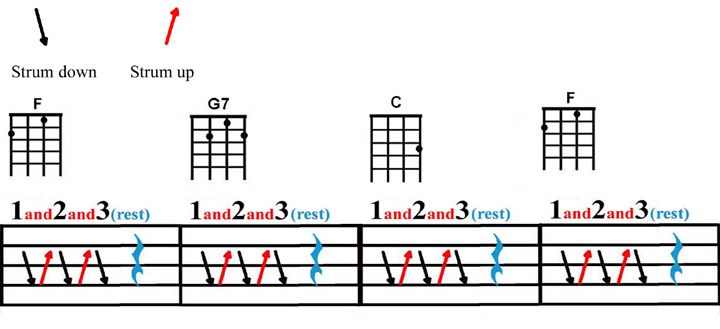
Great! Here is another variation, where the upstroke is thrown in as an "accent" stroke. It is played "down, down, down-up-down, down, down, down-up-down"
give it a try, and when you get to the end, start over...
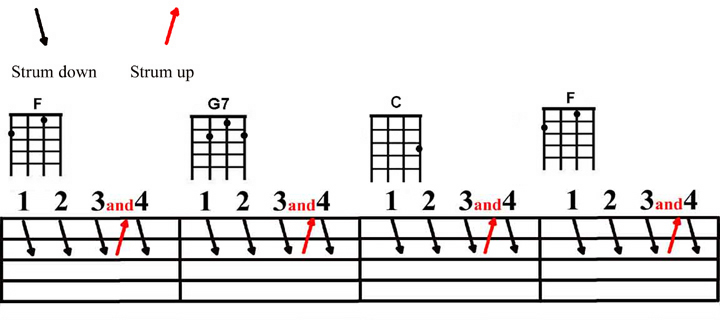
Good. Now lets make it tricky...
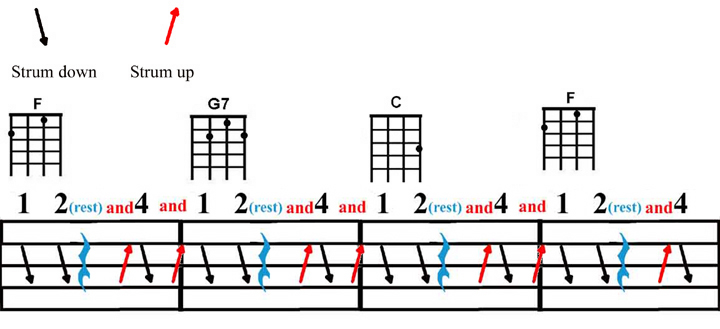
There is almost no end to the combinations. Try mixing them up, and form your own patterns!
So going back to the beginning of this strumming lesson, a good method to learn new strums is to practice to your favorite music. What you can do is "mute" the strings by covering them lightly with your fingers at the top of the neck. Use just enough pressure so that they don't make much sound. Now while listening to your favorite music, (or any music) try to imitate the rhythms you are hearing. You might be amazed at how easy strumming is when you are not thinking about trying to make chords. The more you do this, the easier strumming becomes. once you get a fun pattern down, start adding in chords!
"But I don't know the chords to my favorite songs, and when I found them out on the internets, I didn't know how to make them! What ever shall i do?" Why, head on over to the music tools page!
I know what yer thinkin", It's great that all this information is free, but I wish I could say thanks somehow... Well, you could toss a tip in the case...
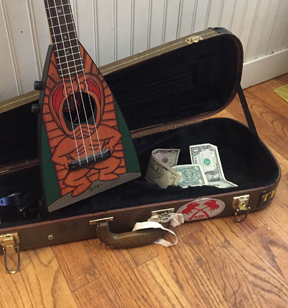
I am also on Venmo! @Tiki-King
Back
I'm in the top 50!


Soooo. After a while, you may find yourself thinking, "My rhythm lacks a certain Je ne sais quois! Each strum produces only a cacophony of ennui" Or, perhaps, "My strumming kinda sucks" The difficulty arises because we are trying to train both the right and left hemispheres of the brain at the same time. Not only that but we are dealing with rhythm, which is a mechanical function, and melody, which is an artistic function. so what to do? Well, the short answere is, practice, practice, practice. This is where a lot of people have trouble, and where it gets a little more complicated. As I said before, strumming is one of those things that could fill an entire book! Musicians work hard to develop unique strums, and some are even famous for the way they strummed, like George Formby, or Roy Smeck. Look these guys up on youtube. You will be amazed. So, good strumming takes practice and there are a couple of ways to go about this. One good way is while you are practicing your strums, don't bother with chords at first, either mute the strings by lightly covering all the strings with your left hand, or just make the easiest chord you can, like a C. Once you get them down, add in the chords. Now, we already know the 4/4 down stroke, and it's not too exciting. So how can we spice it up? Well, first lets add an upstroke. An upstroke is basically just the reverse of the down stroke, where you strum up instead of down. But usually you do the up stroke with your index finger instead of your thumb. So, Down with your thumb, up with your finger. The Upstroke happens between the down strokes. If you are counting 1, 2, 3, 4, the upstroke would be "1 and 2 and 3 and 4 and"... with the upstroke happening on the word "and"
Play it a few times until it feels comfortable

Once you get the hang of the upstroke, lets mix it up a little, and throw in a "rest". A "rest" is counted but not played. So in the following example, you would count "1 and 2 and 3 and 4 and 1 and 2 and 3 and 4 and..." but you would be playing "1 and 2 and 3 (pause) 1 and 2 and 3 (pause)" and so on...
When you get to the end, start over. Keep playing until it gets easy.

Great! Here is another variation, where the upstroke is thrown in as an "accent" stroke. It is played "down, down, down-up-down, down, down, down-up-down"
give it a try, and when you get to the end, start over...

Good. Now lets make it tricky...

There is almost no end to the combinations. Try mixing them up, and form your own patterns!
So going back to the beginning of this strumming lesson, a good method to learn new strums is to practice to your favorite music. What you can do is "mute" the strings by covering them lightly with your fingers at the top of the neck. Use just enough pressure so that they don't make much sound. Now while listening to your favorite music, (or any music) try to imitate the rhythms you are hearing. You might be amazed at how easy strumming is when you are not thinking about trying to make chords. The more you do this, the easier strumming becomes. once you get a fun pattern down, start adding in chords!
"But I don't know the chords to my favorite songs, and when I found them out on the internets, I didn't know how to make them! What ever shall i do?" Why, head on over to the music tools page!
I know what yer thinkin", It's great that all this information is free, but I wish I could say thanks somehow... Well, you could toss a tip in the case...

I am also on Venmo! @Tiki-King
Back
I'm in the top 50!